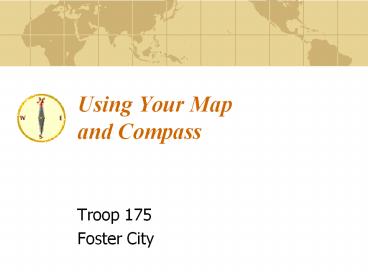Using%20Your%20Map%20and%20Compass - PowerPoint PPT Presentation
Title:
Using%20Your%20Map%20and%20Compass
Description:
Rotate the map and compass together until the red end of the compass needle points north. ... Take a bearing across the river (AB) Add 90 degrees to it (AB 90) ... – PowerPoint PPT presentation
Number of Views:140
Avg rating:3.0/5.0
Title: Using%20Your%20Map%20and%20Compass
1
Using Your Map and Compass
- Troop 175
- Foster City
2
Topographical Maps
3
Topographical Map Info
4
Map Contour Lines
5
Contour Lines
6
Determine Land Shape
7
More About Contours
8
Map Symbols
9
Symbols and Colors
- Black - man-made features such as roads,
buildings, etc. - Blue - water, lakes, rivers, streams, etc.
- Brown - contour lines
- Green - areas with substantial vegetation (could
be forest, scrub, etc.) - White - areas with little or no vegetation white
is also used to depict permanent snowfields and
glaciers - Red - major highways boundaries of public land
areas - Purple - features added to the map since the
original survey. These features are based on
aerial photographs but have not been checked on
land.
10
Topographical Map Symbols
Railroad
Large Falls/Rapids
Mine
Woods
11
Topographical Map Symbols
Trail
Campground / Picnic Area
Small Falls/Rapids
Glacier
12
Topographical Map Symbols
Scrub
Highway
Lake
Sand
13
What Can YOU Tell From a Map?
14
(No Transcript)
15
Your Compass
16
The Basics!
- The first thing you need to learn are the
directions. - North
- South
- East
- West
- Look at the figure and learn where they are.
- North is the most important.
17
Parts of the Compass
The compass needle. On some compasses it might be
red and white for instance, but the point is, the
red part of it is always pointing towards the
earth's magnetic north pole.
18
Parts of the Compass
The Compass Housing. On the edge of the compass
housing, you will probably have a scale. From 0
to 360 degrees. And you should have the letters
N, S, W and E for North, South, West and East.
19
Example I want to go northwest
- You find out where on the compass housing
northwest is. - Then you turn the compass housing so that
northwest on the housing comes exactly there
where the large direction of travel-arrow meets
the housing.
20
Example I want to go northwest
- Hold the compass flat in your hand so that the
compass needle can turn. - Turn yourself, your hand, the entire compass,
just make sure the compass housing doesn't turn. - Turn it until the compass needle is aligned with
the lines inside the compass housing.
21
Lets Do It!
- Stand up
- Using your compass as an aid, move five paces to
the southwest - Go 3 paces to the east
- Travel 5 paces to the northeast
- Now go 3 paces to the west.
- Sit down
22
Lets Do It!
It is extremely important that the red, north
part of the compass needle points at north in the
compass housing. If south points at north, you
would walk off in the exact opposite direction of
what you want! And it's a very common mistake
among beginners. So always take a second look to
make sure you did it right
A second problem might be local magnetic
attractions. If you are carrying something of
iron or something like that, it might disturb the
arrow. Make sure there is nothing of the sort
around.
23
Using Your Map AND Compass Together
24
Using the compass with a map
- Align the edge of the compass with the starting
and finishing point
25
Using the compass with a map
- Rotate the compass housing until the orienting
arrow and lines point N on the map. - Rotate the map and compass together until the red
end of the compass needle points north. - Follow the direction of travel arrow on the
compass, keeping the needle aligned with the
orienting arrow on the housing.
26
Keeping a Bearing
- Hold the compass in your hand, with the needle
well aligned with the orienting arrow. - Then aim in the direction the direction of
travel-arrow is pointing. - Fix your eye on some special feature in the
terrain as far as you can see in the direction.
Then go there. Be sure as you go that the compass
housing doesn't turn.
27
Keeping a Bearing
- Winter conditions can make things a lot worse,
when there is snow on the ground. The fog is
white (or grey), the snow is also white. - Then aim in the direction the direction of
travel-arrow is pointing. - Fix your eye on some special feature in the
terrain as far as you can see in the direction.
Then go there. Be sure as you go that the compass
housing doesn't turn.
28
Measuring the Height of a Tree
- Extend your arm holding a pencil until it is
appears to be the same height as the tree
29
Measuring the Height of a Tree
- Rotate the pencil 90 degrees
- Pick out an object on the ground
30
Measuring the Height of a Tree
- Have a friend pace out the distance.
31
Measuring the Distance Across a River
- Take a bearing across the river (AB)
- Add 90 degrees to it (AB90) (AC)
- Subtract 45 degrees (CB)
- Walk AC until you reach C (Bearing CB)
- Count paces back to A
B
C
A
32
Magnetic Declination
- Align
33
Compass Links
- http//www.learn-orienteering.org/old/lesson1.html
- http//www.trailsillustrated.com/skills/
- http//www.cis.ksu.edu/dha5446/topoweb/guide.html
- http//www.ghosttowns.com/topotmaps.html































